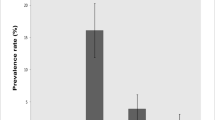Abstract
Laboratory mice infected with a Trypanosoma congolense isolate of water-buffalo origin did not respond when treated with diminazene aceturate (Berenil, Hoechst, West Germany) at 3.5 mg/kg and 7 mg/kg body weight (b.wt.) and also isometamidium chloride (Samorin, May & Baker, Dagenham, England) at doses less than 3 mg/kg b.wt. Effective cure was achieved with isometamidium and diminazene at 3 mg/kg and 14 mg/kg b.wt. respectively; doses in excess of those recommended for use in the field to treat animal trypanosomiasis by the manufacturers. Irregular use of the two drugs on infected water-buffaloes while improperly restrained may be one of the factors responsible for the dual drug resistant T. congolense isolate emerging.
Résumé
Des souris de laboratoire infectées par inoculation avec des isolats de Trypanosoma congolense prélevés sur des buffles n’ont pas réagi à un traitement à l’acéturate de diminazène (B>erénil, Hoechst, Rép. féd. d’Allemagne) dosé à 3,5 et 7 mg/kg de poids vif, ni á des doses de moins de 3 mg/kg de poids vif de chlorure d’isométamidium (Samorin, May & Baker, Dagenham, Angleterre). Pour obtenir une guérison, il a fallu employer des doses de 3 mg/kg de poids vif d’isométamidium et de 14 mg/kg de poids vif de diminazène. Ces doses excèdent celles recommandées par les fabricants pour traiter la trypanosomiase animale sur le terrain. L’usage irrégulier et mal contrôlé de ces deux produits pour le traitement de buffles infectés explique en partie l’émergence d’isolats de T. congolense résistants à ces deux médicaments.
Similar content being viewed by others
References
Abebe G. (1987) Failure of Berenil therapy to eliminate early infection of Trypanosoma brucei from West Abaya, Ethiopia. Trop. Anim. Hlth. Prod. 19, 9–10.
Ali B. H., Hassan T. and Malik K. H. (1985) Clinical evaluation of samorin on Trypanosoma evansi infection in Camelus dromadarius. J. Vet. Pharmac. & Therap. 8, 208–210.
Bauer F. (1962) The development of drug-resistance to Berenil in Trypanosoma congolense. Vet. Rec. 74, 265–266.
FAO (1975) World Production of Animal Protein and Need for New Approach. FAO, Rome AGA/AAAP/75.
Fussgaenger R. and Bauer F. (1960) Susceptibility of Trypanosoma congolense to. Berenil. Vet Rec. 72, 1118.
Gavora J. S. (1982). Disease resistance. In Second World Congress on Genetics Applied to Livestock Production. Vol. V., Madrid, Spain, pp. 143–149.
Gitatha S. K. (1979). Trypanosoma congolense (Shimba Hills) resistant to various trypanocidal drugs. International Scientific Conference on Trypanosomiasis Research and Control, Publ. No. 111, pp. 257–263.
Gray A. R. and Roberts C. J. (1971) The cyclical transmission of strains of Trypanosoma congolense and. Trypanosoma vivax resistant to normal therapeutic doses of trypanocidal drugs. Parāsit. 63, 67.
Hutchings D. A. (1979). Chemotherapy and chemo-prophylaxis in the control of trypanosomiasis. A review with particular reference to Isometamidium. International Scientific Conference on Trypanosomiasis Research and Control, Publ. no. 111, pp. 215–221.
Jones-Davies W. J. (1967) The discovery of Berenil resistant Trypanosoma vivax in. Nigeria. Vet. Rec. 80, 531.
Lohr K. F., Pohlpark S., Srikitjakan L., Thaboran P., Bettermann G. and Staak C. (1985) Trypanosoma evansi infection in water buffaloes in North Eastern Thailand. 1. Field observation. Trop. Anim. Hlth. Prod. 17, 121–125.
NaTsa B. K. (1967). Follow up on a survey of the prevalence of homidium-resistant strains of trypanosomes in cattle in Northern Nigeria and drug cross resistance tests on the strains with samorin and Berenil. Bull. Epizootic Dis. Afr. 15, 23.
Njau B. C, Mkonyi P. A. and Kindamba K. A. M. (1986) The response of trypanosome-infected water-buffaloes and cattle in different areas of fly challenge to normal therapeutic doses of trypanocidal drugs. Insect Sci. Applic. 7, 741–745.
Odhiambo T. R. (1967) East Africa Science for Development. Science 158, 876–881.
Stephen L. E. (1986) Chemotherapy and Chemoprophylaxis of animal trypanosomiasis. Trypanosomiasis, a veterinary perspective. (Edited by Stephen L. E.),pp. 437–533., Pergamon Press, Oxford.
Trail J. M. C, Sones K., Jibbo J. M. C, Durkin J., Light D. E. and Murray M. (1985) Productivity of Boran cattle maintained by chemoprophylaxis under trypanosomiasis risk. ILCA Research Report No. 9, Addis Ababa, Ethiopia, pp. 1–76.
Whiteside E. F. (1963) A strain of Trypanosoma congolense directly resistant to Berenil. J. comp. Pathol. 73, 167–175.
Wiessenhütter E. (1967) Control of trypanosomiasis in Dar-es-Salaam dairy. II. Observations on regular herd treatment with Berenil. Berliner und Münchener Tierärztliche Woehenschrift 80, 27–28.
Williamson J. (1976) Chemotherapy of African trypanosomiasis. Trans. R. Soc. Trop. Med. Hyg. 70, 117.
Wilson A. J., Paris J. and Dar F. K. (1975a) Maintenance of a herd of breeding cattle in an area of high trypanosome challenge. Trop. Anim. Hlth. Prod. 7, 63–71.
Wilson A. J., Le Roux J. G., Paris J. and Davidson C. R. (1975b) Observation on a herd of beef cattle maintained in tsetse area. 1. Assessment of chemotherapy as a method for the control of trypanosomes. Trop. Anim. Hlth. Prod. 7, 187–189.
Author information
Authors and Affiliations
Rights and permissions
About this article
Cite this article
Njau, B.C., Mkonyi, P.A. & Lekaki, K. Susceptibility of a Trypanosoma congolense Isolate of Water-Buffalo Origin to Diminazene Aceturate and Isometamidium Chloride. Int J Trop Insect Sci 9, 461–463 (1988). https://doi.org/10.1017/S1742758400010961
Received:
Revised:
Published:
Issue Date:
DOI: https://doi.org/10.1017/S1742758400010961




